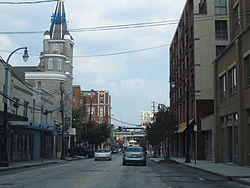Sweet Auburn
|
Sweet Auburn Historic District
|
|

Auburn Avenue, toward the Old Fourth Ward
|
|
| Location | Atlanta, Georgia |
|---|---|
| Coordinates | 33°45′17″N 84°22′53″W / 33.75483°N 84.38131°WCoordinates: 33°45′17″N 84°22′53″W / 33.75483°N 84.38131°W |
| Area | 19 acres (7.7 ha) |
| Built | 1865 |
| Architectural style | Late 19th- & 20th-Century Revival |
| NRHP Reference # | 76000631 |
| Significant dates | |
| Added to NRHP | December 8, 1976 |
| Designated NHLD | December 8, 1976 |
The Sweet Auburn Historic District is a historic African-American neighborhood along and surrounding Auburn Avenue, east of downtown Atlanta, Georgia, United States. The name Sweet Auburn was coined by John Wesley Dobbs, referring to the "richest Negro street in the world," one of the largest concentrations of African-American businesses in the United States. A National Historic Landmark District was designated in 1976, covering 19 acres (7.7 ha) of the neighborhood, significant for its history and development as a segregated area under the state's Jim Crow laws.
Sweet Auburn is one of 242 officially-recognized neighborhoods of Atlanta. It is bounded by:
The first settlement here was on land formerly occupied by Union troops and was called Shermantown for many years. It developed quickly being near the Georgia Railroad and in 1879 was at the endpoint of a newly graded road called simply Boulevard, which led from the railroad to North Avenue near Ponce de Leon Avenue and Angier Springs.
The rise of Auburn Avenue as "the" black business district in Atlanta was to a great extent an outcome of the 1906 Atlanta Race Riot. Prior to this time black businesses operated largely in downtown Atlanta — a business district integrated as far as business ownership was concerned. But competition between working-class whites and blacks for jobs and housing gave rise to fears and tensions. In 1906, print media fueled these tensions with hearsay about alleged sexual assaults on white women by black men, triggering the riot, which left at least 27 people dead (25 of them black) and over 70 injured.,
...
Wikipedia



